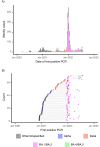Viral kinetics of sequential SARS-CoV-2 infections
- PMID: 37798265
- PMCID: PMC10556125
- DOI: 10.1038/s41467-023-41941-z
Viral kinetics of sequential SARS-CoV-2 infections
Abstract
The impact of a prior SARS-CoV-2 infection on the progression of subsequent infections has been unclear. Using a convenience sample of 94,812 longitudinal RT-qPCR measurements from anterior nares and oropharyngeal swabs, we identified 71 individuals with two well-sampled SARS-CoV-2 infections between March 11th, 2020, and July 28th, 2022. We compared the SARS-CoV-2 viral kinetics of first vs. second infections in this group, adjusting for viral variant, vaccination status, and age. Relative to first infections, second infections usually featured a faster clearance time. Furthermore, a person's relative (rank-order) viral clearance time, compared to others infected with the same variant, was roughly conserved across first and second infections, so that individuals who had a relatively fast clearance time in their first infection also tended to have a relatively fast clearance time in their second infection (Spearman correlation coefficient: 0.30, 95% credible interval (0.12, 0.46)). These findings provide evidence that, like vaccination, immunity from a prior SARS-CoV-2 infection shortens the duration of subsequent acute SARS-CoV-2 infections principally by reducing viral clearance time. Additionally, there appears to be an inherent element of the immune response, or some other host factor, that shapes a person's relative ability to clear SARS-CoV-2 infection that persists across sequential infections.
© 2023. Springer Nature Limited.
Conflict of interest statement
S.M.K. has a consulting agreement with the NBA and Moderna Therapeutics. J.A.H. declares no competing interests. J.R.F. has a consulting agreement for Tempus and receives financial support from Tempus to develop SARS-CoV-2 diagnostic tests. C.M. is an employee of IQVIA, Real World Solutions. C.G.T. is an employee of IQVIA, Real World Solutions. D.J.A. is co-owner of Infection Control Education for Major Sports. D.D.H. declares no competing interests. N.D.G. has a consulting agreement for Tempus and receives financial support from Tempus to develop SARS-CoV-2 diagnostic tests. Y.H.G. has a consulting agreement with the NBA.
Figures



References
Publication types
MeSH terms
Grants and funding
LinkOut - more resources
Full Text Sources
Medical
Miscellaneous

